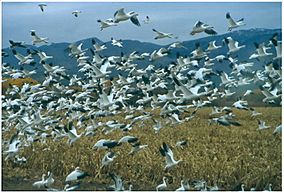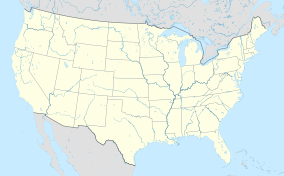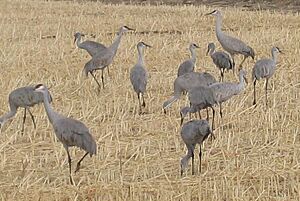Bosque del Apache National Wildlife Refuge facts for kids
Quick facts for kids Bosque del Apache National Wildlife Refuge |
|
|---|---|
|
IUCN Category IV (Habitat/Species Management Area)
|
|

Snow geese at Bosque del Apache
|
|
| Location | Socorro County, New Mexico, United States |
| Nearest city | San Antonio, NM |
| Area | 57,331 acres (232.01 km2) |
| Established | 1939 |
| Visitors | 160,000 (in 2006) |
| Governing body | U.S. Fish & Wildlife Service |
| Website | Bosque del Apache National Wildlife Refuge |
The Bosque del Apache National Wildlife Refuge (boh-SKEH-_-DEL-_-Ə-patch) is a special place in southern New Mexico. It was created in 1939 to protect wildlife. The U.S. Fish and Wildlife Service manages it.
This refuge is a favorite spot to watch Sandhill cranes when they migrate in the fall. It is open all year round. It gives a safe home to many different kinds of animals.
Where is Bosque del Apache?
The name "Bosque del Apache" means "woods of the Apache" in Spanish. It was named after the Apache tribes who used to camp in the forests along the Rio Grande river.
The main part of the refuge covers about 3,800 acres (15 square kilometers) of the Rio Grande floodplain. It also has 9,100 acres (37 square kilometers) of farms and wetlands. On top of this, there are 44,300 acres (179 square kilometers) of dry grasslands. These areas include the foothills of the Chupadera and San Pascual Mountains.
About 30,000 acres (121 square kilometers) of the refuge are set aside as a wilderness area. This means it is kept wild and untouched.
You can drive a 12-mile (19 km) loop road to see the wildlife. This road has two parts: the "Farm Loop" and the "Marsh Loop." There are also several short walking trails, from 1.5 to 10 miles long. These roads let you see the fields where food is grown for the birds. Near the Visitor's Center, there is a garden with desert plants.
What is the Land Like?
About 7,000 acres (28 square kilometers) in the middle of the refuge are flood-plains. These areas get water from irrigation systems connected to the Rio Grande. These flood-plains are important homes for trees like cottonwood and honey mesquite. They also have Goodings and coyote willows, and four-wing saltbushes. These plains are flooded often to help these plants grow well.
The flood-plains also grow food for marshland animals. These plants include smartweed, millet, chufa, bulrush, and sedge. These marshlands are sometimes dried out. They are then burned or turned over to create fresh soil. After that, they are flooded again. This helps new marsh plants grow.
Bosque del Apache also has many acres of dry land. One part has 5,440 acres (22 square kilometers) of scrubland and desert. This area is connected to the Chihuahuan Desert. It is called the Chupadera Peak Wilderness Unit. This unit has tall, reddish cliffs along with its desert land.
Amazing Birds of Bosque del Apache
Since 1981, 374 different kinds of birds have been seen at Bosque del Apache. This makes it one of the best places in the United States to see many different bird species. The wetlands attract huge groups of cranes and geese in winter. These birds are a main attraction of the refuge.
Many other birds also spend the winter here. These include waterfowl, shorebirds, and birds of prey. Sometimes, rare birds like a groove-billed ani or a Rufous-necked Wood-rail are spotted. Outside the Rio Grande area, the refuge also has three special Wilderness areas. These are Chupadera, Little San Pascual, and Indian Well.
The number of different birds is also high in spring, especially in late April and early May. It is also great for birdwatching in the fall. In summer, it gets hot, but you can still find many water birds. These include rare New Mexico birds like the least bittern and sometimes the little blue heron.
The best time to see huge numbers of birds is from late November to late February. You can often see over 10,000 sandhill cranes. Plus, there are usually over 20,000 Ross's and snow geese.
An event called the 'Festival of the Cranes' happens every year. It is held the weekend before Thanksgiving. This is when many cranes start to arrive at the refuge. Visitors often plan to be at the refuge at sunrise or sunset. This is when the cranes and geese fly from their roosting spots to nearby fields to eat. Winter sunrises and sunsets can be cold, but the temperature is usually not far below freezing. Visitors often stay in nearby RV parks or in the towns of Socorro or San Antonio.



